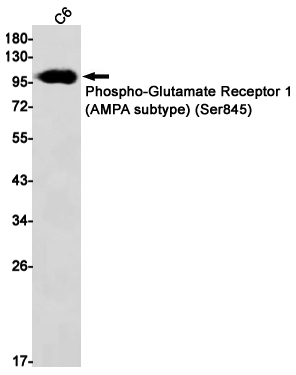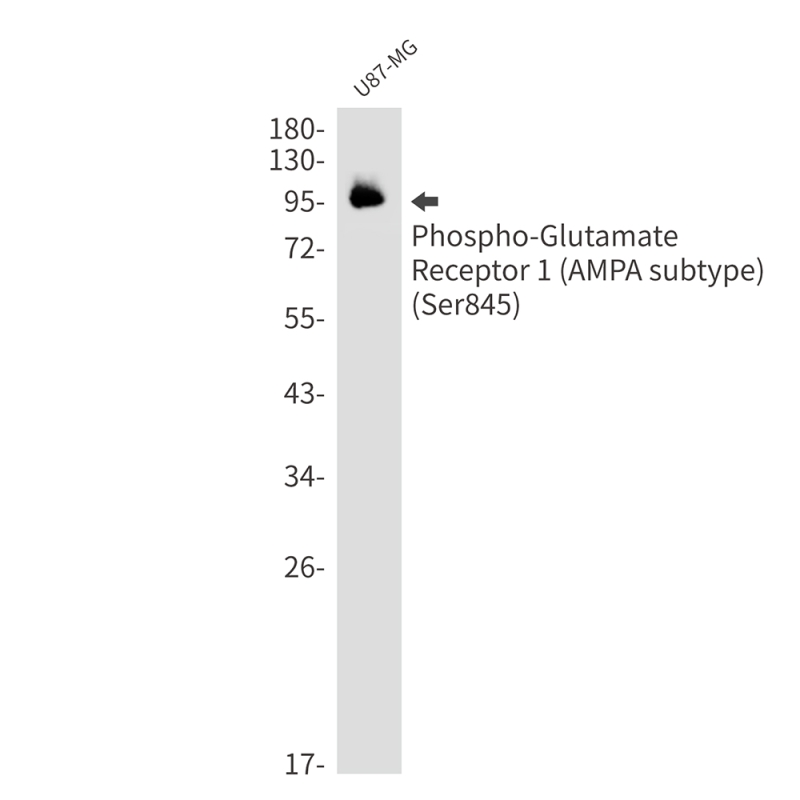

| WB | 咨询技术 | Human,Mouse,Rat |
| IF | 咨询技术 | Human,Mouse,Rat |
| IHC | 咨询技术 | Human,Mouse,Rat |
| ICC | 技术咨询 | Human,Mouse,Rat |
| FCM | 咨询技术 | Human,Mouse,Rat |
| Elisa | 咨询技术 | Human,Mouse,Rat |
| Aliases | GRIA1; GLUH1; GLUR1; Glutamate receptor 1; GluR-1; AMPA-selective glutamate receptor 1; GluR-A; GluR-K1; Glutamate receptor ionotropic; AMPA 1; GluA1 |
| Entrez GeneID | 2890 |
| WB Predicted band size | Calculated MW: 102 kDa; Observed MW: 102 kDa |
| Host/Isotype | Rabbit IgG |
| Antibody Type | Primary antibody |
| Storage | Store at 4°C short term. Aliquot and store at -20°C long term. Avoid freeze/thaw cycles. |
| Species Reactivity | Human,Rat |
| Immunogen | A synthetic phosphopeptide corresponding to residues surrounding Ser845 of human AMPA Receptor 1 (GluA1) |
| Formulation | Purified antibody in TBS with 0.05% sodium azide,0.05%BSA and 50% glycerol. |
+ +
以下是3篇关于Phospho-Glutamate Receptor 1 (Ser845)抗体的参考文献,按研究内容概括:
1. **"Regulation of AMPA receptor-mediated synaptic transmission by clathrin-dependent receptor internalization"**
- **作者**: Lee, S.H. et al.
- **摘要**: 研究AMPA受体Ser845位点磷酸化对其内吞作用的影响,发现去磷酸化可增强受体通过网格蛋白依赖途径的内吞,进而调控突触传递效率。
2. **"Differential regulation of AMPA receptor subunit trafficking by palmitoylation of two distinct sites"**
- **作者**: Hayashi, T. et al.
- **摘要**: 揭示Ser845磷酸化通过调控GluA1亚基的棕榈酰化修饰,影响AMPA受体在突触膜表面的定位与稳定性,从而调节突触可塑性。
3. **"Phosphorylation of the AMPA receptor GluR1 subunit is required for synaptic plasticity and retention of spatial memory"**
- **作者**: Lee, H.K. et al.
- **摘要**: 通过行为学与电生理实验,证明Ser845磷酸化是长时程增强(LTP)和空间记忆形成的关键分子机制,其缺失导致突触功能与记忆受损。
如需具体文献来源或补充其他研究,可进一步说明。
The Phospho-Glutamate Receptor 1 (AMPA Subtype) (Ser845) antibody is a critical tool for studying the regulation of AMPA-type glutamate receptors, which mediate the majority of fast excitatory synaptic transmission in the central nervous system. The GluR1 (or GRIA1) subunit of AMPA receptors is dynamically regulated by phosphorylation at specific serine residues, including Ser845. a key site within its intracellular C-terminal domain. Phosphorylation at Ser845 is primarily mediated by protein kinase A (PKA) and enhances receptor function by increasing channel open probability and promoting synaptic insertion, thereby strengthening synaptic transmission.
This phosphorylation event is closely associated with long-term potentiation (LTP) and synaptic plasticity, processes fundamental to learning and memory. Conversely, dephosphorylation by protein phosphatases, such as calcineurin, correlates with long-term depression (LTD) or receptor internalization. The Phospho-Ser845 antibody specifically detects GluR1 when phosphorylated at this site, enabling researchers to investigate activity-dependent changes in receptor trafficking, synaptic efficacy, and plasticity in both physiological and pathological contexts. It is widely used in techniques like Western blotting, immunohistochemistry, and immunofluorescence to study neurological disorders, including Alzheimer’s disease, epilepsy, and psychiatric conditions linked to AMPA receptor dysregulation. The antibody’s specificity for the phosphorylated form allows precise analysis of GluR1 activation states, making it indispensable for exploring mechanisms underlying synaptic adaptation and neurodegenerative or neuropsychiatric diseases.
×